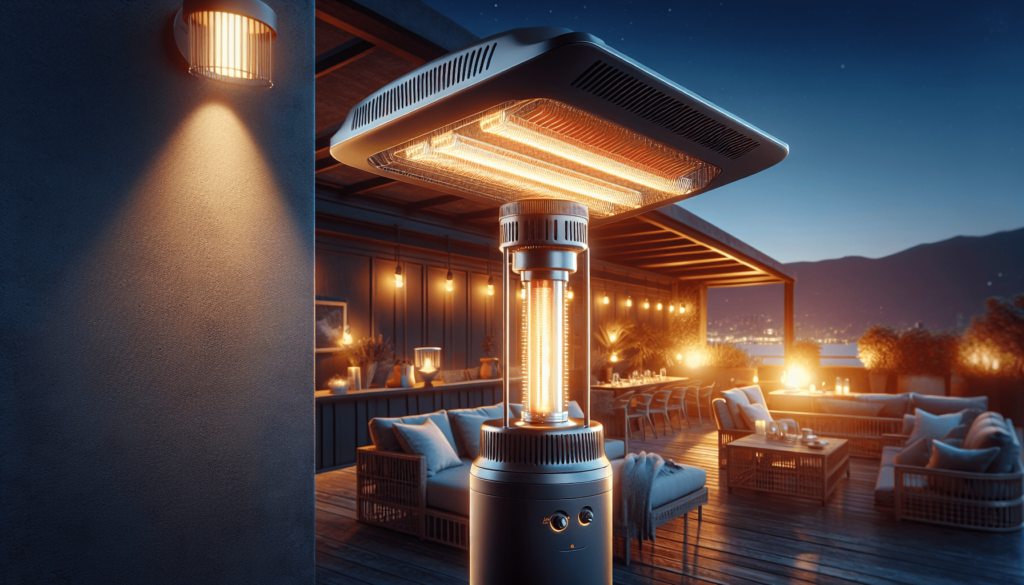
Have you ever found yourself on a chilly evening, cradling a warm drink, wishing you could stay outside just a little bit longer without the cold nipping at your nose? Patio heaters might just be your best friend in these moments, seamlessly blending the joy of outdoor living with the comfort of warmth.
The Basics: What is a Patio Heater?
Patio heaters are devices designed to emit heat in outdoor spaces, ensuring you stay cozy even when the temperature drops. These heaters come in various forms, ranging from freestanding models to tabletop and wall-mounted units. Their primary function is to extend the usability of your outdoor areas, making them welcoming even during colder months.
Types of Patio Heaters
Understanding the various types of patio heaters can help you make an informed choice. Here’s a quick breakdown:
| Type | Description | Fuel Source |
|---|---|---|
| Freestanding | Portable heaters that can be placed anywhere. Often tall and tower-like. | Propane, Natural Gas |
| Tabletop | Smaller heaters designed to sit on top of tables. Suitable for intimate settings. | Propane, Electricity |
| Wall-Mounted | Fixed to walls or ceilings. Ideal for permanent installation and space-saving. | Electricity |
| Hanging | Suspended from ceilings or roofs. Great for covering larger areas from above. | Electricity |
Each type of heater has its own set of advantages, depending on your needs and space constraints. For example, a freestanding heater could be ideal for flexibility, while a wall-mounted unit offers a more permanent, unobtrusive solution.
How Do Patio Heaters Work?
To understand how patio heaters keep you warm, you need to grasp the basic science behind them. Most patio heaters operate on the principle of radiant heat. Radiant heating means the heater warms objects and people directly, rather than heating the air around them. This is similar to how the sun heats the earth, making it an efficient and instant form of warmth.
Radiant vs. Convection Heating
The distinction between radiant and convection heating is crucial. Convection heating warms the air, which then circulates to spread warmth. This method can be less effective in outdoor settings because the heated air can easily escape. Conversely, radiant heating directly targets objects and people without much heat loss, making it more suitable for open spaces.
Here’s a comparison to illustrate this better:
| Heating Method | Description | Pros | Cons |
|---|---|---|---|
| Radiant | Directly heats objects and people. | Instant warmth, less energy wastage | Limited coverage, more focus needed |
| Convection | Warms the air around it, which then circulates. | Good for enclosed spaces | Less effective outdoors, energy loss |
Most high-quality patio heaters utilize radiant heat for this very reason. Brands like Bromic and AZ Patio Heaters have developed sophisticated designs to maximize the efficiency of radiant heating.

Types of Fuel Sources
Patio heaters can be powered by various fuel sources, each having its own benefits and limitations. Here’s a closer look:
Propane
Propane heaters are popular due to their mobility and ease of use. They often come equipped with a propane tank stored in the base.
Advantages:
- Portability: Ideal for spaces where electrical outlets are scarce.
- Instant Heat: Quick to start and heat up.
- Availability: Propane is easily accessible.
Limitations:
- Fuel Replenishment: Requires regular replacement of propane tanks.
- Cost: May be more expensive over time compared to natural gas.
Natural Gas
Natural gas patio heaters are connected directly to your home’s gas line, making them a more permanent fixture.
Advantages:
- Cost-Effective: Generally cheaper to run compared to propane.
- Convenience: No need to replace fuel tanks.
- Constant Supply: Unlimited fuel as long as you have a gas connection.
Limitations:
- Installation: Requires professional setup.
- Mobility: Fixed in one location.
Electric
Electric heaters offer an eco-friendly and convenient option, often used for both wall-mounted and tabletop models.
Advantages:
- Ease of Use: Simply plugs into an outlet.
- Safety: No open flames.
- Environmentally Friendly: Lower emissions.
Limitations:
- Power Dependency: Requires a nearby electrical outlet.
- Operating Cost: Can be more expensive to operate in the long run compared to natural gas.
Each fuel source provides different benefits, so consider your specific requirements when choosing a patio heater. For instance, if you have a large outdoor space and don’t want to worry about fuel replacement, a natural gas heater might be your best bet. On the other hand, if you need something portable, a propane heater could be more suitable.
Safety Features to Look For
Safety is paramount when using any heating device, especially in outdoor settings. Modern patio heaters come equipped with several safety features designed to minimize risks.
Tip-Over Protection
This feature automatically shuts off the heater if it is knocked over. It’s particularly important for freestanding and tabletop units, which could be susceptible to strong winds or accidental bumps.
Overheating Protection
To prevent any risk of fire, many heaters have built-in sensors that detect when the unit is becoming too hot and automatically shut it down.
Anti-Tilt Switch
An anti-tilt switch functions by cutting off the fuel supply if the heater is tilted beyond a certain angle, greatly reducing the risk of a fuel leak.
Flame Failure Device
If the flame goes out unexpectedly, this device shuts off the gas supply to prevent any leaks. This is a common feature in gas heaters.
Brands like Sunjoy and Hampton Bay incorporate these safety mechanisms in their patio heaters, ensuring both functionality and peace of mind.

Installation and Maintenance Tips
Proper installation and regular maintenance can extend the lifespan of your patio heater and ensure it operates safely and efficiently.
Installation Guidelines
- Location: Choose a well-ventilated area. Ensure the heater is placed away from flammable materials and is stable.
- Mounting: For wall-mounted or hanging heaters, follow the manufacturer’s instructions carefully and ensure secure attachment.
- Fuel Access: For propane heaters, ensure the tank is easily accessible for replacement. For natural gas heaters, a certified professional should handle the gas line connections.
Maintenance Tips
- Regular Cleaning: Dust and debris can accumulate on the heater, affecting its efficiency. Clean the exterior and any vents regularly.
- Check for Leaks: For gas heaters, regularly inspect connections and hoses for leaks. Apply a mixture of water and soap to the joints; if bubbles form, you have a leak.
- Inspect the Ignition: Ensure the ignition system is functioning correctly. Clean or replace the igniter if necessary.
- Store Properly: When not in use for extended periods, store the heater in a dry place and cover it to protect it from the elements.
Routine maintenance not only ensures safety but also maximizes the heater’s performance and longevity. Brands like Fire Sense and Dyna-Glo offer robust maintenance guides with their products, making it easier for you to keep your heater in top shape.
Environmental Impact
With growing awareness of environmental concerns, it’s important to consider the ecological footprint of your patio heater. Electric heaters are generally more eco-friendly due to lower emissions. However, it’s essential to recognize the source of your electricity, whether it’s from renewable energy or fossil fuels.
Propane and Natural Gas
Both propane and natural gas are fossil fuels, though natural gas burns cleaner than propane. Efforts to reduce environmental impact could include using bio-propane, a renewable form of propane made from biological sources.
Electric Heaters
Electric heaters produce zero emissions on-site and can be quite efficient. Pairing an electric heater with a renewable energy source, like solar panels, can significantly reduce your carbon footprint.
Here’s a quick comparison of their environmental impacts:
| Fuel Source | Environmental Impact |
|---|---|
| Propane | Emits greenhouse gases but can be minimized using bio-propane. |
| Natural Gas | Cleaner than propane but still a fossil fuel. |
| Electricity | No on-site emissions, but the overall impact depends on your energy source. Low impact if renewable. |
By being mindful of fuel choices and considering renewable options, you can enjoy your patio heater while being kind to the planet.
Cost Considerations
The cost of operating a patio heater can vary depending on the type and fuel source. Here’s a broad estimate to help guide your decision:
Initial Purchase and Installation
- Freestanding Propane Heater: $150 – $500
- Wall-Mounted Electric Heater: $100 – $400 (Installation may vary)
- Natural Gas Heater: $200 – $800 (Professional installation may add $150 – $300)
Operating Costs
| Heater Type | Fuel Source | Cost Estimate (per hour) |
|---|---|---|
| Freestanding | Propane | $0.50 – $1.00 |
| Wall-Mounted | Electric | $0.10 – $0.20 |
| Natural Gas | Natural Gas | $0.15 – $0.30 |
These estimates can vary based on the model and local energy costs. It’s wise to consider both the upfront and ongoing costs when choosing a patio heater.
Choosing the Right Patio Heater for You
With so many options and factors to consider, selecting the right patio heater might seem overwhelming. Here are some quick tips to help simplify this process:
Assess Your Space
- Size Matters: Larger spaces will require more powerful heaters. Freestanding or hanging heaters can cover larger areas effectively.
- Location: Decide if you need a portable option or if you can install a fixed unit. Wall-mounted heaters save space and provide a more permanent solution.
Evaluate Your Needs
- Frequency of Use: If you’re frequently entertaining outdoors, investing in a natural gas or electric heater might be more cost-effective in the long run.
- Climate Considerations: For areas with harsher winters, a powerful propane or natural gas heater may provide the necessary warmth.
Safety and Convenience
- Safety Features: Ensure your chosen heater has essential safety features such as tip-over protection, overheating sensors, and flame failure devices.
- Ease of Maintenance: Opt for heaters with easily accessible components for easier maintenance and cleaning.
Budget
- Upfront Costs: Consider the initial purchase price along with installation fees.
- Operating Costs: Calculate estimated fuel or electricity usage to understand ongoing expenses.
By weighing these factors, you can make an informed decision and select a patio heater that best suits your needs and budget.
Brands to Consider
There are several reputable brands to consider when looking for a reliable patio heater. Here are a few notable mentions:
Bromic Heating
Known for their sleek designs and powerful heating capabilities, Bromic offers both electric and gas-fueled options. Their heaters are often praised for their efficiency and durability, making them a popular choice for homeowners seeking high-quality performance.
Mr. Heater
Mr. Heater offers a range of portable and fixed outdoor heating solutions, particularly popular for their propane models. Their heaters are known for being robust and user-friendly, with many featuring quick-ignition systems and comprehensive safety features.
AZ Patio Heaters
AZ Patio Heaters provides a wide variety of heaters at competitive prices. They cater to both budget-conscious consumers and those looking for more luxurious models. From tabletop heaters to large freestanding units, they offer options to suit various needs and preferences.
Hampton Bay
Available through Home Depot, Hampton Bay’s patio heaters are known for their robust build and efficient performance. They offer a range of styles and fuel types, making them a versatile choice for any outdoor setting.
Conclusion
Patio heaters are an essential addition to any outdoor living space, extending the cozy comfort of your home to the great outdoors. By understanding the science behind their operation, the types and fuel sources available, and the safety features to look out for, you can make an informed decision that meets your needs and preferences.
Whether you’re enjoying a quiet evening alone or hosting a lively outdoor gathering, patio heaters ensure that warmth and comfort are never compromised. Make sure to choose a model that balances efficiency, safety, and environmental considerations to enhance your outdoor experience and keep the chill at bay.




